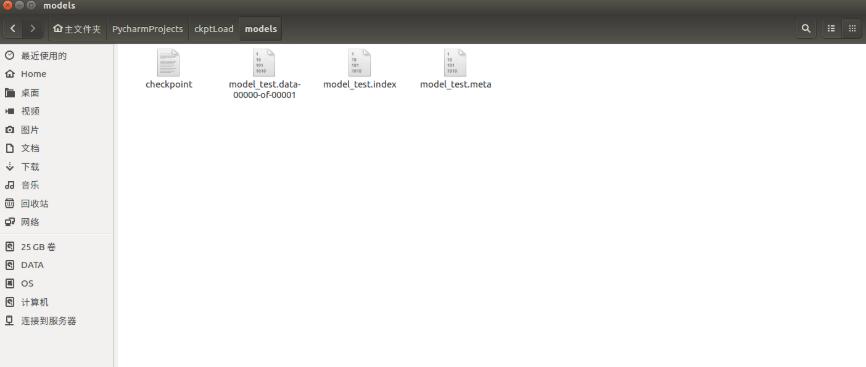tensorflow ckpt,pb模型持久化及转化 tensorflow的ckpt及pb模型持久化方式及转化详解
郑大汪 人气:1使用tensorflow训练模型的时候,模型持久化对我们来说非常重要。
如果我们的模型比较复杂,需要的数据比较多,那么在模型的训练时间会耗时很长。如果在训练过程中出现了模型不可预期的错误,导致训练意外终止,那么我们将会前功尽弃。为了解决这一问题,我们可以使用模型持久化(保存为ckpt文件格式)来保存我们在训练过程中的临时数据。、
如果我们训练出的模型需要提供给用户做离线预测,那么我们只需要完成前向传播过程。这个时候我们就可以使用模型持久化(保存为pb文件格式)来只保存前向传播过程中的变量并将变量固定下来,这时候用户只需要提供一个输入即可得到前向传播的预测结果。
ckpt和pb持久化方式的区别在于ckpt文件将模型结构与模型权重分离保存,便于训练过程;pb文件则是graph_def的序列化文件,便于发布和离线预测。官方提供freeze_grpah.py脚本来将ckpt文件转为pb文件。
CKPT模型持久化
首先定义前向传播过程;
声明并得到一个Saver;
使用Saver.save()保存模型;
# coding=UTF-8 支持中文编码格式
import tensorflow as tf
import shutil
import os.path
MODEL_DIR = "/home/zheng/PycharmProjects/ckptLoad/Models/"
MODEL_NAME = "model.ckpt"
#下面的过程你可以替换成CNN、RNN等你想做的训练过程,这里只是简单的一个计算公式
input_holder = tf.placeholder(tf.float32, shape=[1], name="input_holder") #输入占位符,并指定名字,后续模型读取可能会用的
W1 = tf.Variable(tf.constant(5.0, shape=[1]), name="W1")
B1 = tf.Variable(tf.constant(1.0, shape=[1]), name="B1")
_y = (input_holder * W1) + B1
predictions = tf.add(_y, 50, name="predictions") #输出节点名字,后续模型读取会用到,比50大返回true,否则返回false
init = tf.global_variables_initializer()
saver = tf.train.Saver() #声明saver用于保存模型
with tf.Session() as sess:
sess.run(init)
print "predictions : ", sess.run(predictions, feed_dict={input_holder: [10.0]}) #输入一个数据测试一下
saver.save(sess, os.path.join(MODEL_DIR, MODEL_NAME)) #模型保存
print("%d ops in the final graph." % len(tf.get_default_graph().as_graph_def().node)) #得到当前图有几个操作节点
predictions : [ 101.]
28 ops in the final graph.
注:代码含义请参考注释,需要注意的是可以自定义模型保存的路径
ckpt模型持久化使用起来非常简单,只需要我们声明一个tf.train.Saver,然后调用save()函数,将会话模型保存到指定的目录。执行代码结果,会在我们指定模型目录下出现4个文件

checkpoint : 记录目录下所有模型文件列表
ckpt.data : 保存模型中每个变量的取值
ckpt.meta : 保存整个计算图的结构
ckpt模型加载
# -*- coding: utf-8 -*-)
import tensorflow as tf
from numpy.random import RandomState
# 定义训练数据batch的大小
batch_size = 8
#下面的过程你可以替换成CNN、RNN等你想做的训练过程,这里只是简单的一个计算公式
input_holder = tf.placeholder(tf.float32, shape=[1], name="input_holder") #输入占位符,并指定名字,后续模型读取可能会用的
W1 = tf.Variable(tf.constant(5.0, shape=[1]), name="W1")
B1 = tf.Variable(tf.constant(1.0, shape=[1]), name="B1")
_y = (input_holder * W1) + B1
predictions = tf.add(_y, 50, name="predictions") #输出节点名字,后续模型读取会用到,比50大返回true,否则返回false
#saver=tf.train.Saver()
# creare a session,创建一个会话来运行TensorFlow程序
with tf.Session() as sess:
saver = tf.train.import_meta_graph('/home/zheng/Models/model/model.meta')
saver.restore(sess, tf.train.latest_checkpoint('/home/zheng/Models/model'))
#saver.restore(sess, tf.train.latest_checkpoint('/home/zheng/Models/model'))
# 初始化变量
sess.run(tf.global_variables_initializer())
print "predictions : ", sess.run(predictions, feed_dict={input_holder: [10.0]})
代码结果,可以看到运行结果一样
predictions : [ 101.]
PB模型持久化
定义运算过程
通过 get_default_graph().as_graph_def() 得到当前图的计算节点信息
通过 graph_util.convert_variables_to_constants 将相关节点的values固定
通过 tf.gfile.GFile 进行模型持久化
# coding=UTF-8
import tensorflow as tf
import shutil
import os.path
from tensorflow.python.framework import graph_util
MODEL_DIR = "/home/zheng/PycharmProjects/pbLoad/Models/"
MODEL_NAME = "model"
#output_graph = "model/pb/add_model.pb"
#下面的过程你可以替换成CNN、RNN等你想做的训练过程,这里只是简单的一个计算公式
input_holder = tf.placeholder(tf.float32, shape=[1], name="input_holder")
W1 = tf.Variable(tf.constant(5.0, shape=[1]), name="W1")
B1 = tf.Variable(tf.constant(1.0, shape=[1]), name="B1")
_y = (input_holder * W1) + B1
predictions = tf.add(_y, 50, name="predictions")
init = tf.global_variables_initializer()
with tf.Session() as sess:
sess.run(init)
print "predictions : ", sess.run(predictions, feed_dict={input_holder: [10.0]})
graph_def = tf.get_default_graph().as_graph_def() #得到当前的图的 GraphDef 部分,
#通过这个部分就可以完成重输入层到
#输出层的计算过程
output_graph_def = graph_util.convert_variables_to_constants( # 模型持久化,将变量值固定
sess,
graph_def,
["predictions"] #需要保存节点的名字
)
with tf.gfile.GFile(os.path.join(MODEL_DIR,MODEL_NAME), "wb") as f: # 保存模型
f.write(output_graph_def.SerializeToString()) # 序列化输出
print("%d ops in the final graph." % len(output_graph_def.node))
print (predictions)
# for op in tf.get_default_graph().get_operations(): 打印模型节点信息
# print (op.name)
结果输出
predictions : [ 101.]
Converted 2 variables to const ops.
9 ops in the final graph.
Tensor("predictions:0", shape=(1,), dtype=float32)

并在指定目录下生成pb文件模型,保存了从输入层到输出层这个计算过程的计算图和相关变量的值,我们得到这个模型后传入一个输入,既可以得到一个预估的输出值
pb模型文件加载
# -*- coding: utf-8 -*-)
from tensorflow.python.platform import gfile
import tensorflow as tf
from numpy.random import RandomState
sess = tf.Session()
with gfile.FastGFile('./Models/model', 'rb') as f:
graph_def = tf.GraphDef()
graph_def.ParseFromString(f.read())
sess.graph.as_default()
tf.import_graph_def(graph_def, name='') # 导入计算图
# 需要有一个初始化的过程
sess.run(tf.global_variables_initializer())
# 需要先复原变量
sess.run('W1:0')
sess.run('B1:0')
# 输入
input_x = sess.graph.get_tensor_by_name('input_holder:0')
#input_y = sess.graph.get_tensor_by_name('y-input:0')
op = sess.graph.get_tensor_by_name('predictions:0')
ret = sess.run(op, feed_dict={input_x:[10]})
print(ret)
输出结果
[ 101.]
我们可以看到结果一致。
ckpt格式转pb格式
通过传入 CKPT 模型的路径得到模型的图和变量数据
通过 import_meta_graph 导入模型中的图
通过 saver.restore 从模型中恢复图中各个变量的数据
通过 graph_util.convert_variables_to_constants 将模型持久化
# coding=UTF-8
import tensorflow as tf
import os.path
import argparse
from tensorflow.python.framework import graph_util
MODEL_DIR = "/home/zheng/PycharmProjects/ckptToPb/model/"
MODEL_NAME = "frozen_model"
def freeze_graph(model_folder):
checkpoint = tf.train.get_checkpoint_state(model_folder) #检查目录下ckpt文件状态是否可用
input_checkpoint = checkpoint.model_checkpoint_path #得ckpt文件路径
output_graph = os.path.join(MODEL_DIR, MODEL_NAME) #PB模型保存路径
output_node_names = "predictions" #原模型输出操作节点的名字
saver = tf.train.import_meta_graph(input_checkpoint + '.meta', clear_devices=True) #得到图、clear_devices :Whether or not to clear the device field for an `Operation` or `Tensor` during import.
graph = tf.get_default_graph() #获得默认的图
input_graph_def = graph.as_graph_def() #返回一个序列化的图代表当前的图
with tf.Session() as sess:
saver.restore(sess, input_checkpoint) #恢复图并得到数据
print "predictions : ", sess.run("predictions:0", feed_dict={"input_holder:0": [10.0]}) # 测试读出来的模型是否正确,注意这里传入的是输出 和输入 节点的 tensor的名字,不是操作节点的名字
output_graph_def = graph_util.convert_variables_to_constants( #模型持久化,将变量值固定
sess,
input_graph_def,
output_node_names.split(",") #如果有多个输出节点,以逗号隔开
)
with tf.gfile.GFile(output_graph, "wb") as f: #保存模型
f.write(output_graph_def.SerializeToString()) #序列化输出
print("%d ops in the final graph." % len(output_graph_def.node)) #得到当前图有几个操作节点
if __name__ == '__main__':
#parser = argparse.ArgumentParser()
#parser.add_argument("model_folder", type=str, help="input ckpt model dir") #命令行解析,help是提示符,type是输入的类型,
# 这里运行程序时需要带上模型ckpt的路径,不然会报 error: too few arguments
#aggs = parser.parse_args()
#freeze_graph(aggs.model_folder)
freeze_graph("/home/zheng/PycharmProjects/ckptLoad/Models/") #模型目录
注意改变ckpt模型目录及pb文件保存目录 。

运行结果为
predictions : [ 101.] Converted 2 variables to const ops. 9 ops in the final graph.
总结:cpkt文件格式将模型保存为4个文件,pb文件格式为一个。ckpt模型持久化方式将图结构与权重参数分开保存,多了模型更多的细节,适合模型训练阶段;而pb持久化方式完成了从输入到输出的前向传播,完成了端到端的形式,更是个离线使用。
以上这篇tensorflow的ckpt及pb模型持久化方式及转化详解就是小编分享给大家的全部内容了,希望能给大家一个参考,也希望大家多多支持。
加载全部内容